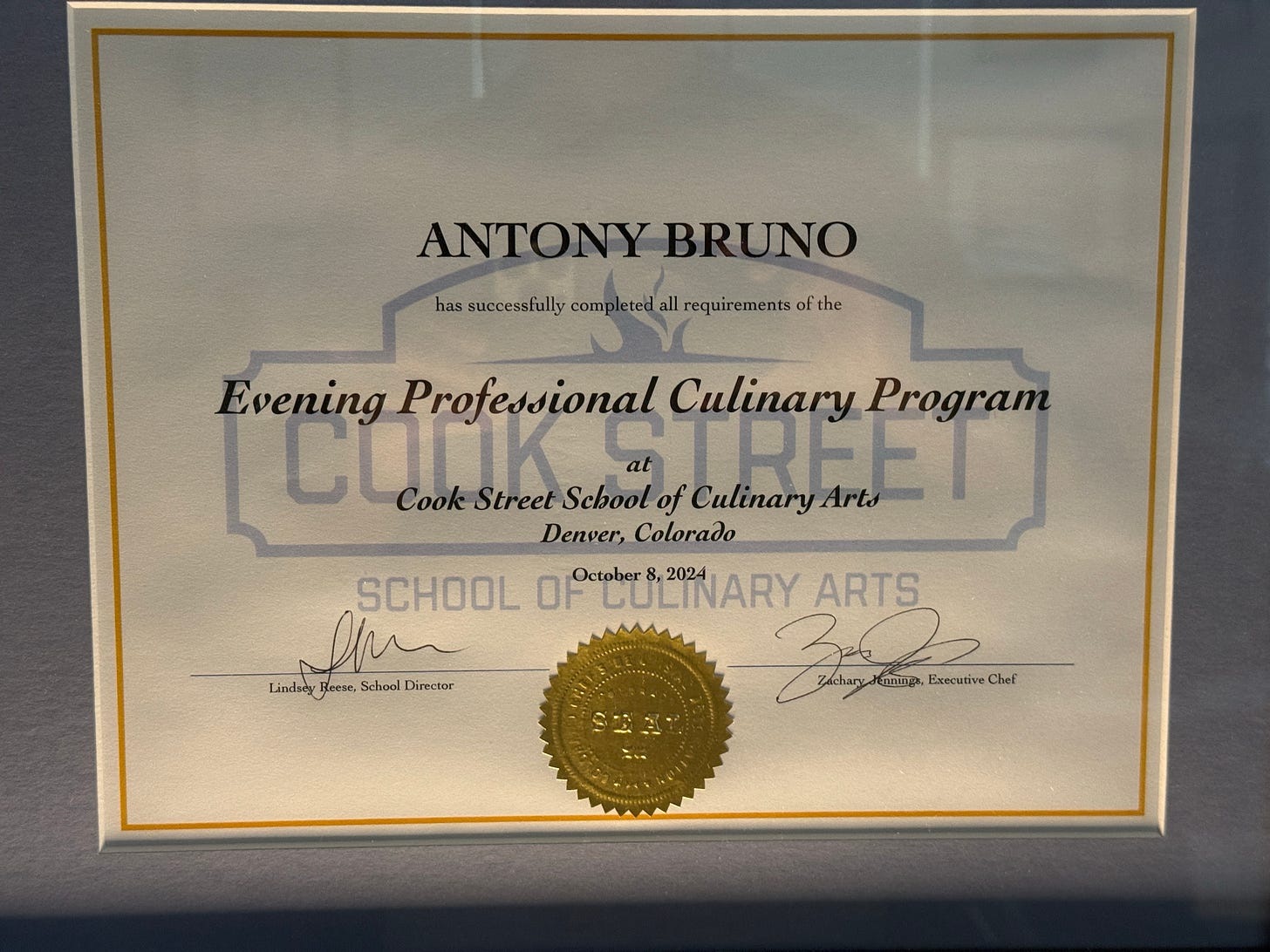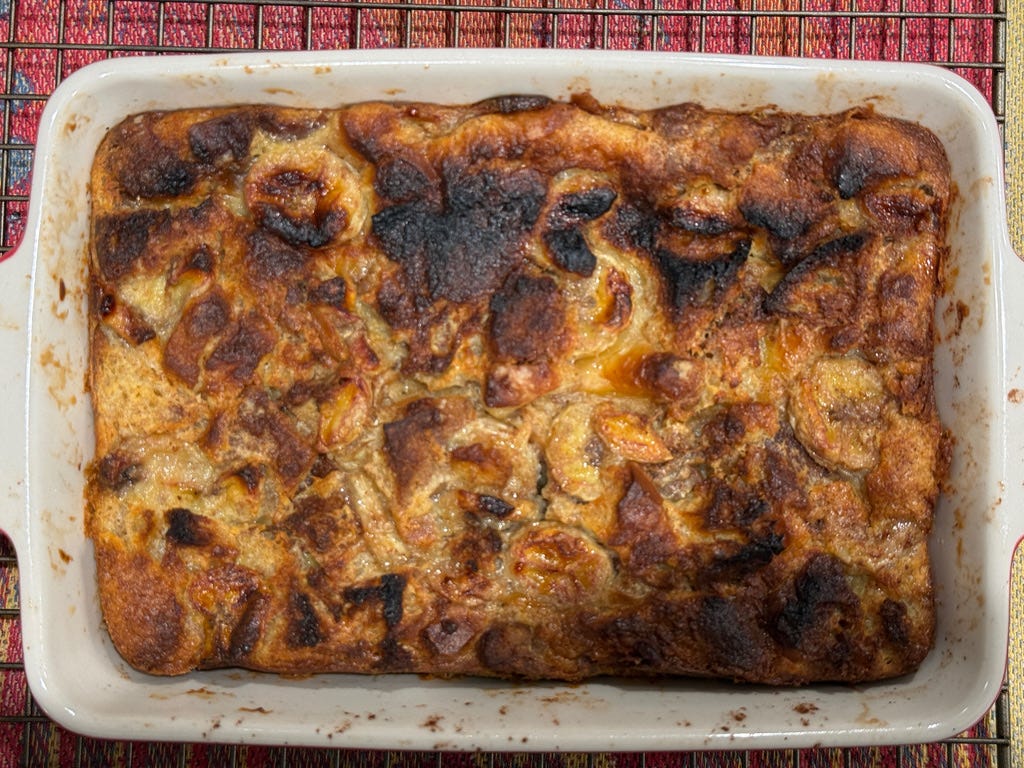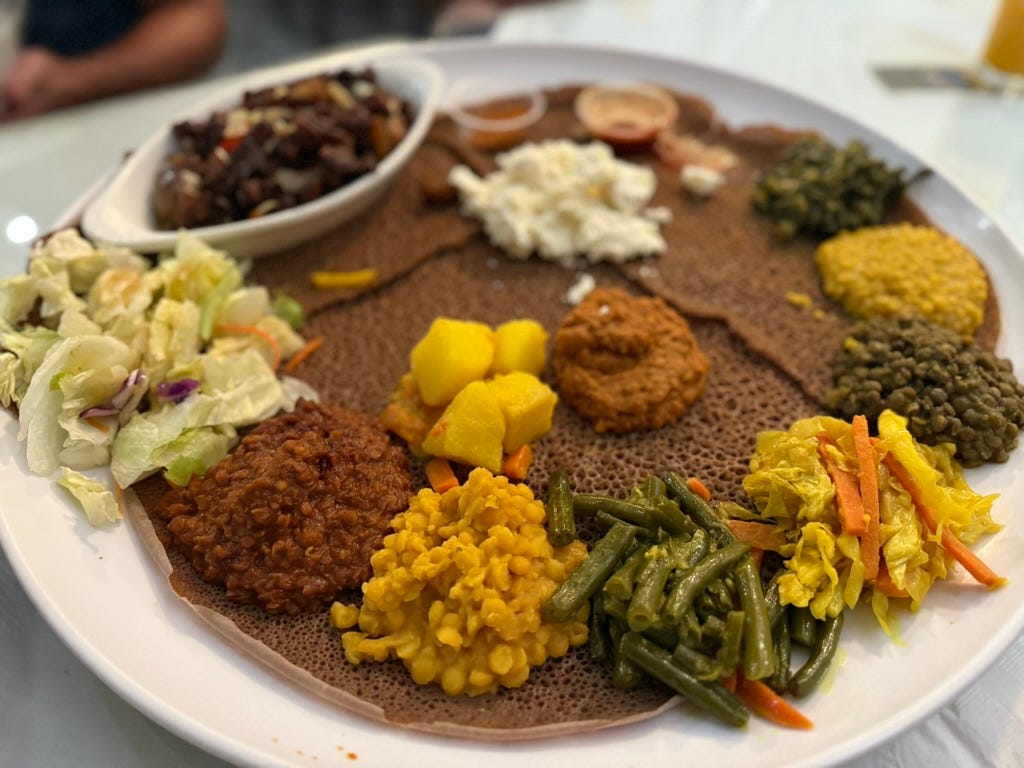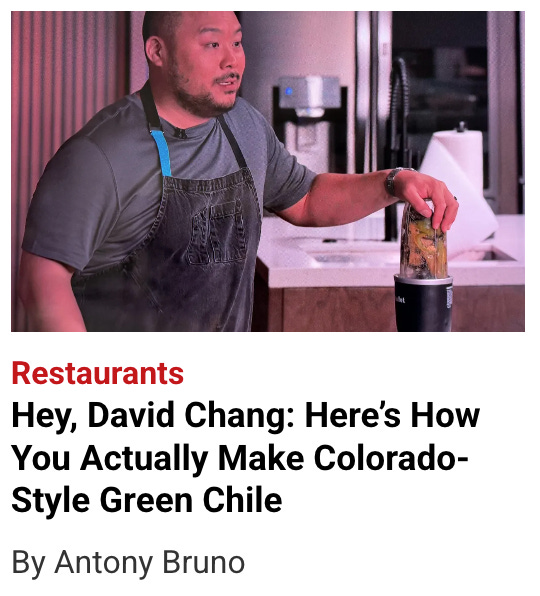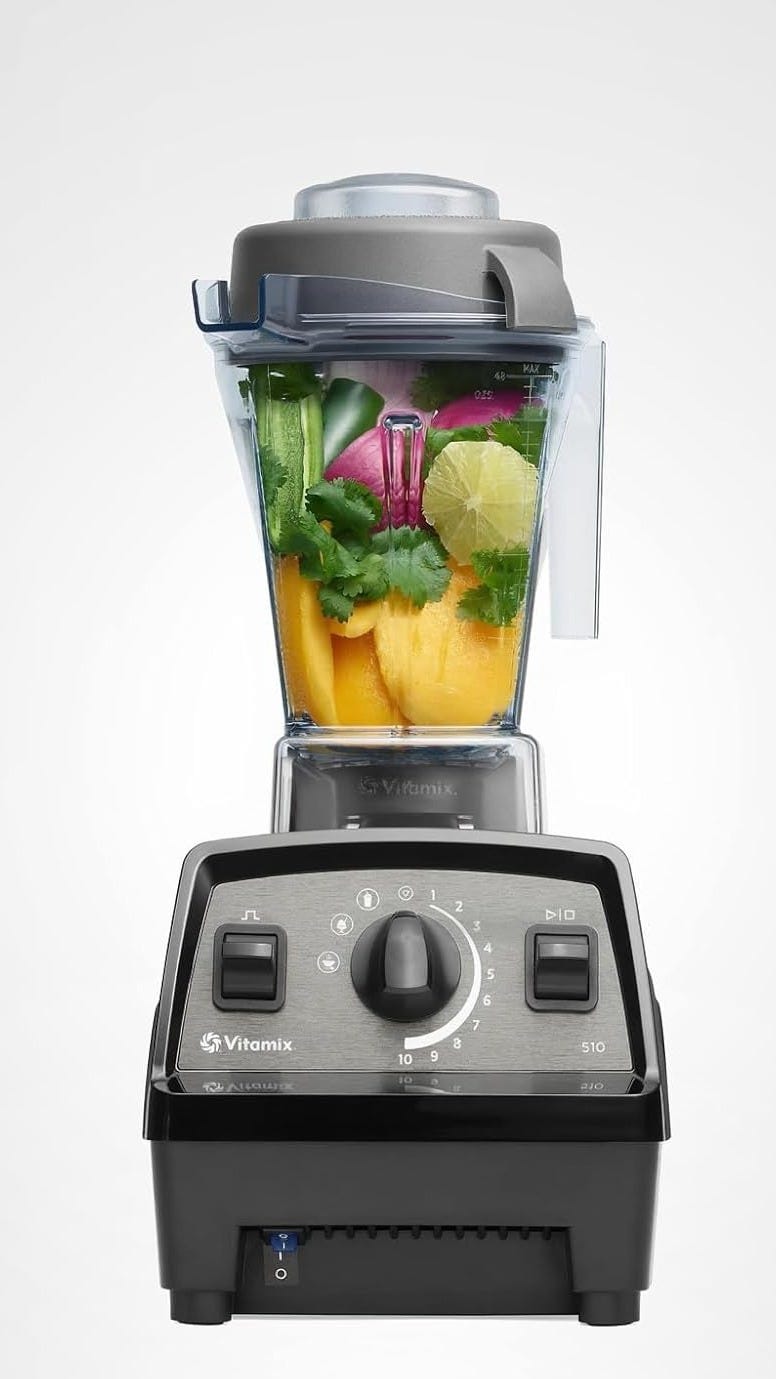Cooked/Uncooked... Reheated
We're back!
So… it’s been over a year since the last Cooked/Uncooked dispatch. But I’ve decided to pull it out from the back of the fridge, check the expiration date, pop in in the microwave, and see if there’s any flavor left.
Why now? Well… a lot’s happened since I put the newsletter on hiatus and I’ve got a whole lot more to say about food, cooking, restaurants, wine, and more. I’m keeping the name and the focus on food, but changing up the format quite a bit to something that you’ll hopefully find even more interesting than the first iteration.
What’s New/Different?
Now that I’m done w/ culinary school (today’s actually the 1-year graduation anniversary) Cooked/Uncooked will focus more on the the culinary discoveries I’m making as a freelance food writer. In the last year+, I’ve had the good fortune to contribute to several local publications, including 5280, Dining Out Denver, and Westword, and I’m starting to pitch national pubs as well.
I come across a lot of interesting places to eat, cooking experiences to share, wines to recommend, and stories/books/TV/movies to enjoy all under the Cooked/Uncooked culinary umbrella. There are also a lot of outtakes, insights, and behind-the-scenes stuff that don’t make it into my published stories I think subscribers will find interesting.
So without further ado…
Cooking: Donut Bread Pudding
The EPA estimates that discarded food represents about a quarter of all solid waste found in municipal landfills. An obvious way to reduce that is to find uses for ingredients you might otherwise throw away.
Fortunately, many of the most popular and delicious dishes ever created were designed to do exactly that. Before there was fine dining and haute cuisine, there was the “cocina povera” or “poor kitchen” where home cooks found delicious ways to make use of everything they had. Throwing away food just wasn’t an option.
A perfect example of this is bread pudding… an easy-to-make dish designed to make use of stale bread. But it’s not only limited to bread. I’m writing a story about the many donut shops along a stretch of street in Denver’s south burbs, and as such have bought a fair amount of donuts. One trick to staying in reasonable shape as a food writer is to not eat everything you’re served. So I had a lot of leftover donuts going stale on my kitchen counter (since the wife and daughter weren’t exactly doing their part).
I also had some staling bread heels. Normally I’d make croutons from those, but I figured combining them with the donuts could be a great dessert. After all, you can make bread pudding with pretty much any kind of bread-like product: donuts, cake or cupcakes, hell maybe even bagels (I’ve not yet tried bagels, so don’t hold me to this). I had glazed donuts and half an apple fritter.
Now you don’t really need a recipe to make bread pudding. It’s a pretty straightforward ratio that you can apply to whatever you have on hand. There’s actually two ratios involved: one for bread-to-custard, and another for the custard.
Bread Pudding Ratio: 1x bread to 2x custard. That means weigh the bread/donuts you have on hand, and then make twice that weight in custard. I had 8oz of mixed bread and donuts, so I needed 16oz of custard.
Custard Ratio: 1 egg for every 1 cup of dairy (whole milk or half-and-half). We know that 1 cup of liquid = 8oz. So two cups of dairy plus 2 eggs (and 3-4 tbls of sugar) makes 16oz (actually slightly more, but it’s always good to have a little leftover just in case).
Blend the dairy, egg, sugar, and about a half tsp of vanilla on high for several minutes until the yolks are fully emulsified into the dairy. (If you don’t blend it enough, the egg will separate during baking, resulting in an eggy bottom of the bread pudding.)
Tear your donuts and bread/whatever into bite-sized pieces and place in a baking pan that will hold it all. Maybe throw in a little fruit (I sliced up a banana). Sprinkle it with some cinnamon. Pour in custard until it covers the solids, and let sit for at least a half hour for it all soak in.
Then bake at 375 for about 1.5 hours. The bread/donuts will swell and rise a bit above the custard, but that’s good because you want a sort of crispy top to contrast with the custardy interior when serving.
Serve as is, or with a sauce. You can even pour melted ice cream over it and call it creme anglaise (which is what ice cream is before churning).
I promise you it’s that easy. You don’t need to search for a bunch of recipes, most of which don’t have the right amount of ingredients you have on hand. Just weigh what you have, use the ratios, and you’ll have a perfectly acceptable dessert.
Eating: Havana Street Recommendations
I had written a few stories for Denver’s alt-weekly newspaper Westword when food editor Molly Martin asked if I’d be interested in writing a series profiling a different restaurant each week located along Havana Street in the suburb of Aurora. This is known as the most diverse street in Colorado, where you can find restaurants representing the cuisines of a wide range of cultures. Korean, Chinese, Japanese, African, Mexican, Middle Eastern… it’s all there.
Since I’ve always wanted to explore Havana Street and it’s restaurants, this was a dream gig, so I jumped at the chance. I’ve been writing this series all year ever since. There are over 30 restaurant profiles live now, with another dozen or so left before I reach the end of the street.
Here are some of my favorites so far. If you’re in the Denver area, make sure to give these a visit:
Nile Ethiopian (not yet published)
Drinking: Where’s The Love Denver?
Writing about wine in Denver is like trying to write about skiing in Florida. Sure there are plenty of people here who love wine. But it’s not considered a “wine town.”
Since I started freelancing, I’ve been trying to establish myself with at least one outlet as the go-to wine guy. Problem is, most of them don’t care much about wine stories. Beer writer? Yes. Food truck writer? Sure. Cannabis writer? Of course! But wine writer? Meh.
Even so, I’ve managed to get a few published locally, and am now looking for a foothold in national outlets. I’ll have the opportunity to visit Paso Robles in a few weeks as part of a press tour of local producers, so more to come on that. Meanwhile, enjoy these articles:
Somebody People Serves Up Vegan Food, Vibes and Vino (Westword)
Inside Hop Alley’s James Beard–Recognized Wine Program (5280)
Denver Is Finally Tapping Into the Keg-Based Wine Trend (5280)
Reading
Interesting stories about food, wine, and restaurants worth sharing:
Denver’s Restaurants Are Dying (Slow Boring). My take: Yes, things are bad. I see and hear it from nearly every restaurant owner I interview. But there are plenty of people also making it work. I’m not smart enough to have the answers. But if I get a vote, I’m all for giving the people actually making the food more money, even if that’s at the expense of the owners or the servers. Come find me.
Opening A Restaurant In New York Is No Picnic (NYT). Read this, and then consider that even New Yorkers say that opening a restaurant in Denver is harder than doing so in New York.
Swag, Soul & Skin Contact: Inside Vino Out The Trunk’s Cultural Revolution (Nothing Added). This is a fascinating snapshot of everything that most traditional wine writing is not. A group of friends holding a monthly wine-fueled hangout just for the pure pleasure it brings. No tasting grid. No douchy, pretentious faux insights about terrior. I wanted to profile the event in Westword, but the folks hosting it declined. Admirably, they wanted to keep it a private hang. My loss. But a great read.
Watching: Dinner Time Live with David Chang (Netflix)
The episodes can be hit or miss depending on the guests. But what I love about it is how Chang doesn’t hide his cooking mistakes. In fact, he draws attention to them, and you can see how upset it makes him sometimes. As a home cook, it’s refreshing to be reminded that even the best cooks screw up too.
Fun side note: I got excited watching a recent episode when he said he was going to make a Colorado Slopper. (A Slopper is a open-faced cheeseburger smothered in green chile). But what he made wasn’t even close. A few days later I mentioned it to Molly at Westword, and she suggested I write up something “fun” poking fun at Chang for falling far short of the Slopper mark.
The result is the story in the photo above (click the photo to read).
That’s how fast a story can happen… from side comment to published story in a day.
Snarky clickbait story aside, it’s a great show that I love watching, and I’ve always been a huge Chang fan.
Recommending: Prime Day Vitamix
I’m not a huge fan of over-consumption in the retail/shopping sense (all for it in the gastronomic sense!) so typically not a big Prime Day groupie. But… each time they feature a sale on what I consider a must-have kitchen item — the Vitamix blender.
These are VERY expensive blenders, but absolutely worth it. Professional grade. Powerful as hell. You need that power to break up sautéed solids into liquid form, which form the basis of elevated sauces and purees. I use mine almost weekly.
Typically they’re close to $500, but the Prime Day sale is $350. Buy it here. (This is a clean link. No affiliate revenue coming my way on this. Just 100% from the heart).


